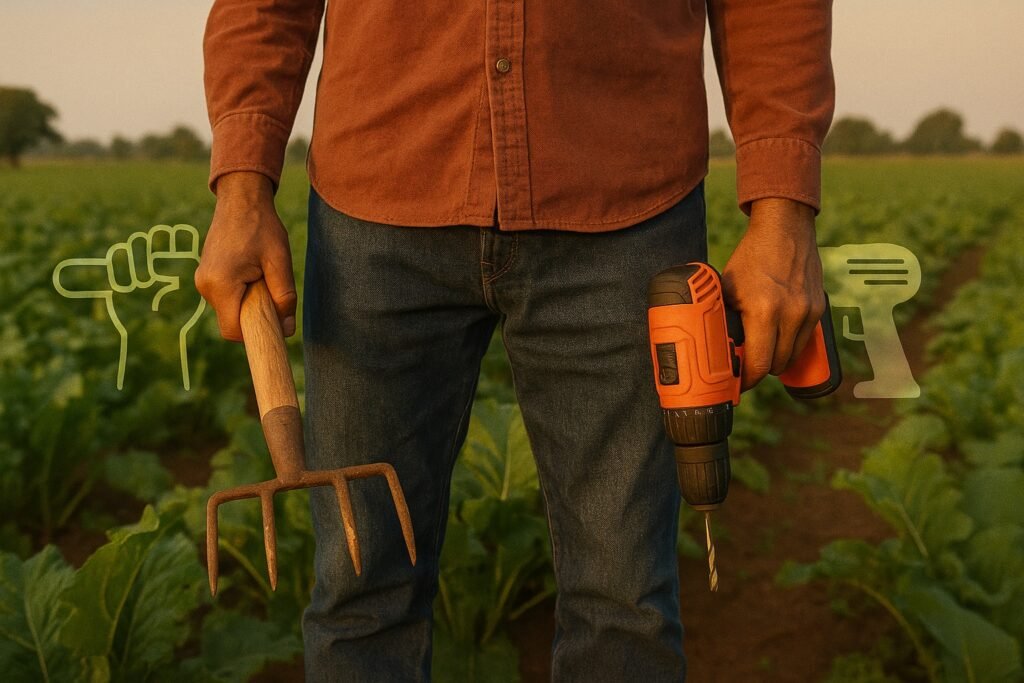Small farms thrive on efficiency, precision, and adaptability. Whether cultivating vegetables, maintaining orchards, or managing mixed-use plots, the choice between hand-operated and power tools can define productivity and profitability. Both have advantages, but their suitability depends on land size, crop type, labor availability, and budget.
The Role of Tools in Small-Scale Farming
Tools on a small farm do more than just finish chores; they also determine how quickly things move along. With a powered cultivator, a weeding operation that takes three hours with manual hoes may be completed in thirty minutes. However, speed isn’t always the decisive element. For fragile crops, accuracy could be more important than speed.
Farmers also take into account physical strain, continuous maintenance, and energy input. Many times, the choice is not either/or but rather a combination, combining mechanical tools for some jobs and hand tools for others.
Cost Efficiency and Initial Investment
The initial comparison between power and hand tools is based on cost. The initial cost of hand-operated tools is much lower, typically ranging from $10 to $100 per item. For example, the cost of a high-quality wheel hoe is far lower than that of motorized alternatives when it comes to planting, weeding, and cultivating.
Depending on quality and size, power instruments like chainsaws and tillers demand bigger initial investments, ranging from $300 to $2,000. Although they might result in labour savings, it might take years for extremely small farms to break even.
Purchasing agricultural equipment is one way for farmers on a tight budget to meet their basic needs without taking on large debt. This method is particularly popular in micro-farms that are smaller than one acre, where portability and adaptability are more important than horsepower.
Physical Effort vs. Mechanical Assistance
Although they require more physical effort, hand-operated equipment offer the user more control. They are ideal for precise farming tasks, such as transplanting seedlings or growing on raised beds. Because manual tools do not bear the weight of engines, they also lessen soil compaction.
Power tools significantly reduce physical strain for repetitive or heavy-duty jobs. For example:
- A power auger drills fence post holes in minutes compared to hours with a manual post hole digger.
- A powered mower can clear half an acre in less than an hour, while manual options may take an entire day.
The choice often comes down to striking a balance between energy expenditure and efficiency.
Maintenance and Longevity
Maintaining hand-operated tools is easier. Their lifespan may typically be increased to decades by cleaning metal components, changing handles, and sharpening blades. Because of their endurance, several 1930s-era farm tools are still in use today.
In contrast, power tools require regular maintenance, including oil changes, filter cleanings, and replacement of worn mechanical parts. Their lifespan can be considerably shortened by poor upkeep. Nonetheless, machines that receive regular maintenance can operate efficiently for ten to fifteen years.
According to a University of Vermont Extension resource, seasonal maintenance and proper storage can prolong the life of both mechanical and manual tools, thereby avoiding expensive replacements.
Environmental Impact and Sustainability
The use of hand-operated tools is clearly advantageous for small farms looking to lower their carbon footprint. They don’t use fossil fuels to run and don’t emit any direct emissions. Additionally, by reducing forceful tillage, which can upset microbial ecosystems, manual cultivation promotes soil health.
Fuel or electricity use by power tools results in pollution and increased resource extraction during manufacturing. Battery-powered tools, on the other hand, are becoming a more environmentally friendly option due to their lower emissions and quieter operation.
Versatility in Different Farming Conditions
When working on tight or uneven plots that are inaccessible to large machinery, hand-operated tools are often more effective. Additionally, they function well in damp environments where power tools could jeopardise human safety or cause engine damage.
Power tools are most effective on large, uniform plots. In a fraction of the time, a small tractor equipped with various attachments can effectively plow, seed, and weed multiple acres.
Combining both technologies frequently offers the greatest flexibility for farms with diverse topography.
“Tools don’t just change the way we work; they change the way we think about work.”
Labor Availability and Skill Requirements
Because work may be shared without causing severe weariness, small farms with plenty of family or community labour frequently rely more on manual tools. Additionally, it encourages the development of traditional farming skills.
Although they require skilled operators, power tools eliminate the need for big labour forces. Safety becomes crucial because abuse can result in accidents, lost time, and extra expenses. To optimise benefits and minimise dangers, operators must receive the appropriate training.
Output Speed and Productivity Gains
According to time studies, power tools can boost output by 50–70% when compared to hand tools for operations like harvesting and soil preparation. However, the productivity gap narrows or even flips in favour of manual instruments for detailed tasks like pruning or planting small seedlings.
For example, in tiny beds, a hand-operated jab planter can plant some crops more quickly and precisely than a machine seeder. On the other hand, for crops like grains or root vegetables grown on bigger plots, a powered harvester is unparalleled.
Seasonal Flexibility and Weather Dependence
Hand tools perform consistently throughout the year with little variation. Other than operator comfort, rain, snow, and high heat have little effect.
Weather can have an impact on power tools, particularly those that run on gasoline in cold or damp circumstances. Colder temperatures can shorten battery life, reducing operating time.
Seasonally adaptive instruments increase total farm resilience by minimizing delays caused by mechanical breakdowns or adverse weather, according to a SARE (Sustainable Agriculture Research & Education) report.
Long-Term Financial Aspects
Power tools can drastically save labour hours, which might be crucial for farms with a shortage of workers, even though hand tools are initially less expensive. Cost per hour of operation over a number of years is frequently the deciding factor.
Farmers can determine which tools provide the highest long-term return by calculating the total ownership cost, which includes the purchase price, fuel, maintenance, and repairs. To reduce overall costs, many small farms opt to rent or share power tools for seasonal work.
FAQs on Choosing Between Hand-Operated and Power Tools
- Which is better for very small farms under one acre?
Hand-operated tools are generally more cost-effective and easier to use for small plots. - Do power tools always save time?
Not always. They excel in large-scale repetitive tasks but may not outperform manual tools in precision work. - Are battery-powered tools worth it for small farms?
Yes, especially for noise reduction, lower emissions, and easier maintenance compared to gas-powered tools. - How can I reduce the costs of power tools?
Consider renting, buying second-hand, or sharing equipment with neighboring farms. - What safety considerations are important for power tools?
Proper training, personal protective equipment, and routine inspections are essential.
Looking Forward: Blending Tradition with Technology
Hybrid systems, in which power tools manage labor-intensive, time-sensitive tasks while hand tools preserve crop quality and soil health, are becoming more and more valuable to small farms. This combination enables farmers to embrace time and energy-saving advances while preserving traditional practices.
The difference between mechanical and manual tools will probably get smaller as technology develops, with ergonomic manual designs and lightweight electric machinery altering the scene. Small-scale farming will keep developing by incorporating the best aspects of both into day-to-day operations rather than picking one side and sticking with it.





